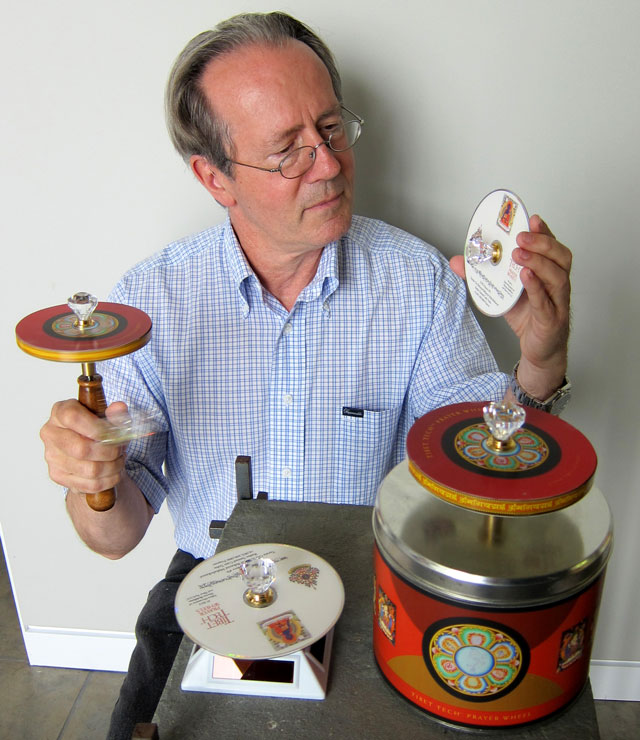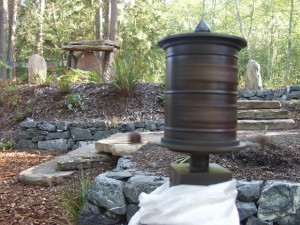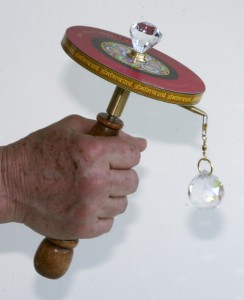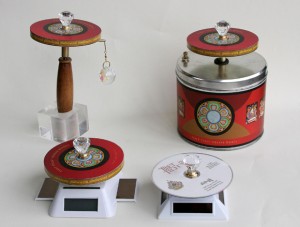Tibet Tech Packs Prayers on DVD Wheels
Written by: Chuck Pettis

Chuck Pettis, creator of the Tibet Tech prayer wheel.
Photo by Claudia Pettis
Tibet Tech, created to offer an array of traditional Tibetan Buddhist prayer wheels based on modern technology, is now shipping prayer wheels to practitioners around the world from a tiny shop on Whidbey Island, Wash.
The prayer wheels are the creation of Chuck Pettis, co-executive director of Sakya Monastery in Seattle, and were inspired by guidance from his teachers H.H. Jigdal Dagchen Sakya and H.E. Dagmo Kusho Sakya.
The two “recommended that I use prayer wheels in my daily meditation practice. They gave me two prayer wheels as gifts. One is electric and revolves continuously on my shrine. I hold the other prayer wheel in my hand and spin it while I do spiritual practices,” wrote Pettis, who also is founder of Earth Sanctuary on Whidbey Island.
“When I started spinning the prayer wheels, my wife immediately noticed an increase in the spiritual feeling around our altar,” Pettis wrote. “One day, while meditating, the question arose in my mind, ‘How many prayers (mantras) could be put in a prayer wheel?’”

Chuck Pettis and Carol Day packing prayer wheels for shipping.
The result is Tibet Tech prayer wheel, each of which contains billions of prayers, packed onto a stack of DVD disks.
“Just one rotation of the prayer wheels is equivalent to reciting prayers for hundreds of years,” Pettis wrote.
Prayer wheels are cylinders filled with many mantras (Tibetan Buddhist prayers) mounted on a spindle, and spun clockwise with intention and prayer. The primary goal of the traditional Tibetan Buddhist prayer wheel practice is to increase happiness and to relieve the miseries of all beings.
We are taught that peace, happiness, kindness, and relief from suffering for all beings are radiated through the blessings of the mantras inside the prayer wheel, and by the intention and concentration of the spiritual practitioner.
Buddhist texts teach that mindfully turning a prayer wheel produces the same merit and benefits as having recited the number of prayers (mantras) inside the prayer wheel, multiplied by how many times the prayer wheel spins around.

The first custom-built Tibet Tech prayer wheel installed at Earth Sanctuary, on Whidbey Island.
Prayer wheels have traditionally been filled with mantras carefully printed on paper or microfilm and then wound up inside the prayer wheel. The largest prayer wheel in Tibet contained 100 million prayers printed on paper with hand-carved wood blocks.
His Holiness Jigdal Dagchen Sakya, one of the most revered Tibetan Buddhist masters and a leader of the Sakya Sect of Tibetan Buddhism, oversaw the design and construction of the Tibet Tech prayer wheels.
At the beginning of the project Dagchen Rinpoche’s wife, H.E. Dagmo Kusho Sakya, and Chuck Pettis, contacted Tarthang Tulku Rinpoche, head lama of the Tibetan Nyingma Meditation Center, who has created over 1,600 prayer wheels. Tarthang Tulku was kind enough to provide a very helpful article, entitled “Prayer Wheels of the Nyingma Centers.”
The construction of the unique Tibet Tech prayer wheel builds on traditional prayer wheel design techniques by incorporating modern computer technology. Tibet Tech prayer wheels are the first to use DVDs to store mantras inside a prayer wheel.

The Tibet-Tech hand-held prayer wheel sending prayers!
H.H. Jigdal Dagchen Sakya selected the mantras, Ven. Yeshi Tulku typed the mantras, and H.H. Jigdal Dagchen Sakya and H.E. Dagmo Kusho Sakya proofread the mantras. Each of the eight mantras contained in the Tibet Tech prayer wheel were placed by Tom Ashbrook, a Sakya Monastery member, into an evenly spaced 10-by-5,000-cell Microsoft Excel worksheet matrix, which was printed to an Adobe Acrobat PDF file containing 50,000 mantras.
One thousand of these PDF files were compressed into a single zip file containing 50 million mantras. For each of the eight mantras, as many of the zipped files as possible were copied to a DVD.
The DVD duplicator uses lasers to read and write mantras onto an opaque reflective layer in 0.4-micron pits in a spiral track.
“Although that is a technically accurate description of the DVD-RW process,” said Ashbrook, “while producing the DVDs it looked to me like the mantras were being written by light onto a rainbow onto the DVD.”
Below and above the stack of DVDs are the Earth Wheel and Sky Wheel symbols, as drawn by Lama Zopa Rinpoche and depicted in the book, “Wheel of Great Compassion: The Practice of the Prayer Wheel in Tibetan Buddhism,” by Lorne Ladner (Wisdom Publications, 2000).

The Tibet Tech prayer wheel line includes hand-held, desktop and solar models.
All the prayers used were blessed and consecrated by H.H. Jigdal Dagchen Sakya. The blessing ceremony has three parts. First the mantras are praised, then the DVDs are consecrated, and finally a dedication of merit prayer is recited to benefit all sentient beings and to work for a more peaceful world. Dagchen Rinpoche has said, “As long as the universe exists, these mantras will remain potent.”
In 2004, the first set of three custom-built Tibet Tech prayer wheels were created by artist and metal craftsman Mike Sweeney, with some engineering assistance from Charlie Pettis (Chuck Pettis’ father). The wheels were then installed at Sakya Monastery’s retreat center, the Tara Meditation Center at Earth Sanctuary, where they have been spun over 1.6 million times by retreatants and visitors.
Due to the density of the prayers on the DVDs, that means the prayer wheels have radiated 1.3 trillion x 1.6 million prayers, to benefit all living beings and help bring peace to Earth.
These initial Tibet Tech prayer wheels were costly works of art to fabricate. Based on testimonials from visitors to Earth Sanctuary, from people who purchased the initial prayer wheels, and requests from people who wanted an affordable Tibet Tech prayer wheel, work began to design cost-effective table-top and hand-held versions of the Tibet Tech prayer wheel.
From 2005 to 2010, Pettis father and son engineered and tested a series of prototypes. (Graphic design was by John Engerman, art director for BrandSolutions, Inc.)
Tibet Tech now offers a full line of prayer wheels: A hand-held Tibet Tech prayer wheel, a table-top Tibet Tech prayer wheel, and a combination hand-held and table-top Tibet Tech prayer wheel. Most recently Tibet Tech started offering a line of solar-powered prayer wheels with DVDs for Chenrezig (Om Mani Padme Hum), Medicine Buddha, Tara, Amitayus, Padmasambhava and Vajrakilaya.
“There are two things that make Tibet Tech prayer wheels important,” wrote Pettis, “First, how they transform the feeling in people’s home and second, the happiness and relief from suffering that so many prayers provide to all people and all beings. May all beings be happy. May all beings be free of suffering!”
